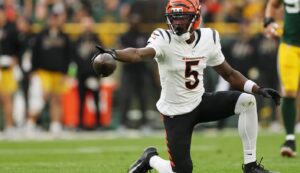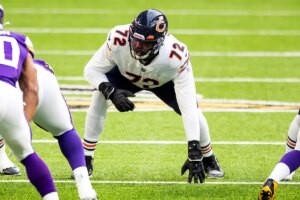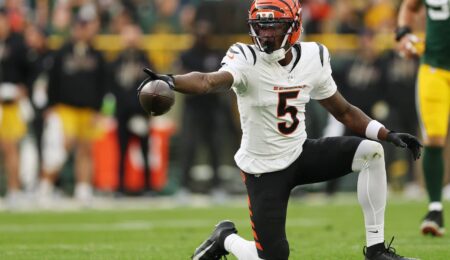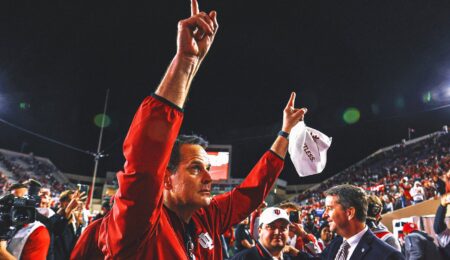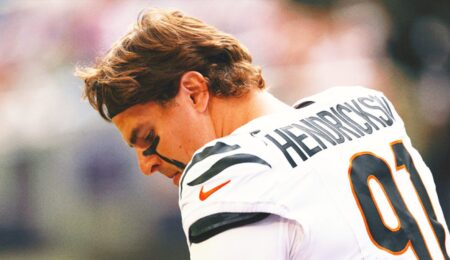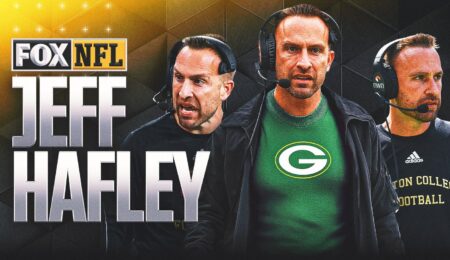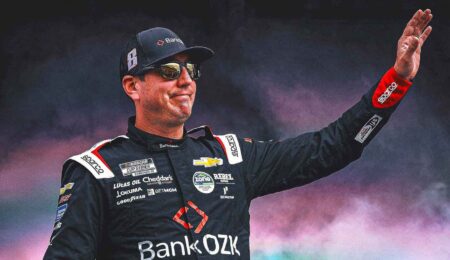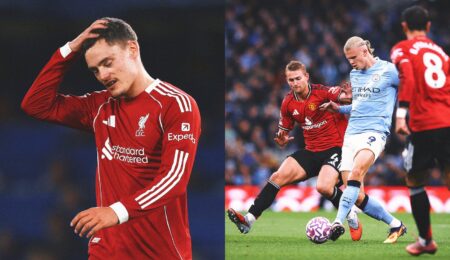LOS ANGELES – On Feb. 19, Mookie Betts made his intentions clear: He was out to prove everybody wrong.
The six-time Gold Glove Award-winning right fielder had spent the offseason painstakingly building a new foundation as a shortstop, perfecting his mechanics through hours upon hours of near-daily work at infields across the Los Angeles area as Dodger Stadium underwent renovations, in an effort to handle the rigors of the position.
He knew people would question the move, but he also knew how much more prepared he felt than he was a year ago, when he was thrust into action at the spot with less than two weeks of notice and attempted to learn on the fly.
“All the people that doubt me,” Betts said this spring, “they’ll see.”
Last year, the Dodgers’ shortstop experiment with Betts ended after he fractured his hand in June. Now, as the Dodgers return to Los Angeles with a 2-0 lead in the National League Championship Series, not only is he firmly entrenched as the Dodgers’ starting shortstop; he’s a Gold Glove finalist at the position after ranking first in MLB among qualified shortstops in defensive runs saved.
“I’m just proud of myself for making it all the way through the year and actually achieving a goal that I kind of set out to do, and that’s being a major league shortstop,” Betts said. “And I can say I did it, and I can say I was good at it.”
Mookie Betts (left) has made himself at home in the middle of the Dodgers infield next to Miguel Rojas (right). (Ronald Martinez/Getty Images)
‘Some kind of special’
For all the belief he had in himself, Betts still didn’t know with any certainty if he’d end the season at shortstop.
But there was a point earlier this year — Betts isn’t sure exactly what day or what game specifically, but it was sometime after his third or fourth error of the season — when he no longer needed to think at the position. When things went awry, he understood what he did wrong and how to fix it.
That’s when he knew he could stick.
“I could just go out there and play,” Betts explained. “And now when I go out and play shortstop, it’s like I’m going out to right field.”
That doesn’t erase the nerves or the butterflies he gets playing shortstop in the postseason for the first time in his career, but he’s handling the position with the same dexterity that he did during the regular season. Through eight postseason games, Betts has 16 assists, 11 putouts and no errors. Since Aug. 2, he has committed just one error.
Pat Murphy, the Brewers manager and the Dodgers’ foe in the NLCS, called him one of the most underrated stars in the game.
“That dude is some kind of special,” Murphy said. “It would be like Steph Curry playing forward, you know what I mean? He could do it because superstars can do that. Mookie is doing something in our game that’s unprecedented.”
The Wheel Play
Eight months after setting out “to prove everybody wrong” this spring, in just his fourth career playoff appearance at shortstop, Betts’ confidence and ease at the position had reached a point that he felt comfortable enough conjuring up an impromptu, game-saving play.
“Sometimes, you’ve got to go rogue,” Betts said. “Sometimes, you’ve got to do things that aren’t normal.”
In the bottom of the ninth of Game 2 of the National League Division Series, the Dodgers’ volatile bullpen was in the midst of blowing a 4-1 lead in Philadelphia. Three straight hits off Blake Treinen put Nick Castellanos 180 feet away with nobody out.
Manager Dave Roberts made a pitching change. Alex Vesia was summoned to try to extinguish the threat. As the wheels were falling off, Betts proposed a potential series-saving idea, a play that Roberts said the Dodgers don’t even practice, but one that Betts remembered teammate Miguel Rojas calling for a couple of months prior in Anaheim.
As Betts’ wheels were turning, the “wheel play” came to mind. His teammates and manager were on board.
“For me, that was our only chance, really, to win that game in that moment,” Roberts said.
The play is basically baseball’s equivalent of a blitz, a bunt coverage that calls for both the first and third basemen to crash home while the shortstop sprints to cover third. Everything has to go right for it to work. If it does, it looks genius. If it doesn’t, it could be costly. Betts and the Dodgers weren’t dwelling on the latter possibility.
“That was just the perfect time to do it,” said Freddie Freeman. “Everything was just perfect on that play.”
Phillies manager Rob Thomson commended the way Betts disguised it. Thomson’s hitters are taught that if they see the wheel, they should pull the bunt back and try to slash a hit with all the open space in the middle of the infield.
But Betts, who was still lingering right behind Castellanos close to the bag at second when Vesia started his delivery, broke so late to third that it was difficult for Stott to pick up. As Vesia threw the pitch, Betts took off. Stott laid the bunt down right to a crashing Muncy, who fired perfectly to third. Betts was a few steps ahead of Castellanos as he applied the tag to get the crucial out as the Dodgers preserved the win and a 2-0 lead in the series.
Mookie Betts’ baseball IQ was on full display in Game 2 against the Phillies. (Terence Lewis/Icon Sportswire via Getty Images)
Betts downplayed the significance of the decision, calling it “a basic play.”
“There’s only, like, two or three ways, and that’s one of them,” he said. “It would be like the Lakers, they won the NBA championship running the 2-3 zone. That’s how I view it. It’s just, we ran it in a big spot, and we were able to do it right.”
For others, though, it was another example of how far Betts had come.
“I hope everyone realizes how hard it is to switch positions,” Freeman said, “and then do it at an elite level that Mookie has done it at.”
It was the culmination of taking grounder after grounder from Dodgers video coordinator Petie Montero this winter, of all the video Betts pored through with infield coach Chris Woodward, of all the ideas he bounced off close friend and Angels infield coach Ryan Goins, of all the advice he received from Rojas and the visit this offseason to former All-Star shortstop Troy Tulowitzki, whose downhill style of attack at the position resonated with Betts.
“To go out there and play Gold-Glove right field for years and to be in the Gold Glove conversation this year, rightfully so, to playing the biggest of games, biggest of stages, it’s just never been done,” Roberts said. “It takes a special brain and talent to do it.”
‘Freeing his mind up’
On Aug. 8, Betts declared his season over.
It wasn’t actually, of course, but even after homering that night, there was no time left to meaningfully repair his .680 OPS in what would inevitably end up his worst offensive season as a big leaguer.
So, he decided to change the way he approached the rest of the year.
“I can help the boys win every night,” Betts said. “Get an RBI, make a play, do something, kind of shift my focus there. Obviously, everyone wants to have great seasons, but it’s a lot easier when you just don’t worry about the season and you just worry about game to game. So, I think I’ll take this perspective for the rest of my career, for sure.”
From that moment through the end of the season, something funny happened — he started to look like his old self again.
Betts registered an .854 OPS the rest of the regular season, and he has a nearly identical .849 OPS through eight postseason games.
“When he kind of said that the year was lost and when he kind of made that admission, that’s when I think it sort of flipped for him,” Roberts said. “Just freeing his mind up.”
All year, Betts insisted that the physical toll of playing shortstop wasn’t the reason for his offensive shortcomings. He considered that an excuse.
“It’s completely different,” he told me in August. “Two sides of the ball. I don’t bring them together. Last year, I was banging. And then, whatever. So, it’s not a good excuse.”
Instead, he attributes the uptick in offensive production primarily to better mechanics and finally getting his strength back after the early-season stomach virus that saw him shed around 20 pounds. Looking back, there might have been a correlation between the freedom he felt in the field and his surge at the plate, too.
“That moment I had where I could just go have fun, play short, then I could kind of flip my brain back to hitting,” Betts said before the wild-card series. “It’s a learned behavior, going back and forth between defense and offense. When I was in right, I didn’t have to do that. I was playing right and didn’t have to think about playing right.
“At first, I was playing short and had to think about everything at short, what came with that, and flip it back to offense. Then, once short became where I didn’t have to think about it anymore, I could really think about offense, I think it slowly and surely started to get better and better.”
Questions about whether Betts might actually help the Dodgers more in the outfield remain, considering the Dodgers’ struggles this year in the corners, but questions about his ability to handle the switch to shortstop have ceased.
He answered them. At 33 years old, he’s succeeding at a task few players of his caliber would have ever attempted.
“I believe in myself,” Betts said. “I believe in what I can do. And now, it’s just like, go have fun.”
Rowan Kavner is an MLB writer for FOX Sports. He previously covered the L.A. Dodgers, LA Clippers and Dallas Cowboys. An LSU grad, Rowan was born in California, grew up in Texas, then moved back to the West Coast in 2014. Follow him on X at @RowanKavner.
Read the full article here


